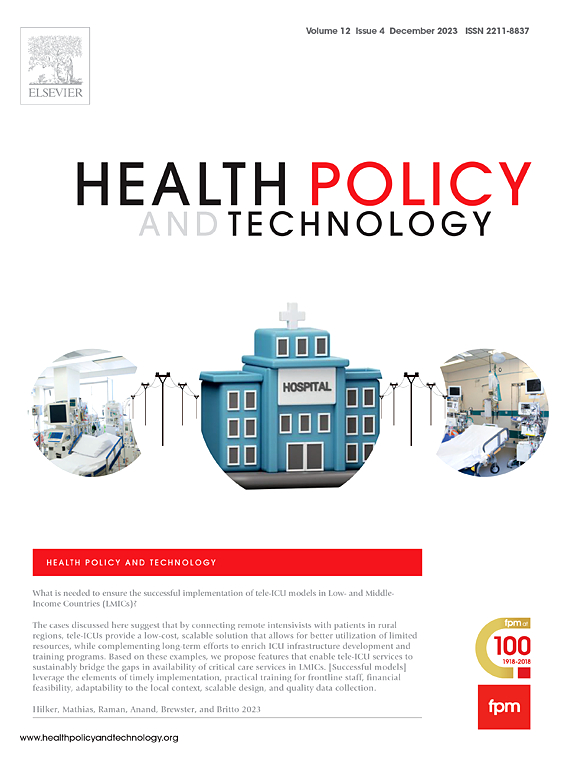Wearable pre-impact fall protection system: a scoping review
IF 3.7
3区 医学
Q1 HEALTH POLICY & SERVICES
引用次数: 0
Abstract
Objective
To review wearable protective devices for individuals at high risk of falling and to analyze the feasibility of these wearable protective tools in reducing fall-related harm.
Design
A systematic search was conducted across 7 databases to identify studies that met the inclusion criteria for analysis.
Results
A total of 31 studies were included. 28 studies involved the design of pre-impact fall protective devices, while 3 studies utilized commercially available products. The primary target population was the elderly, with some designed for children, blind person, and patients with craniocerebral disease. The wearing methods mainly included clothing, accessories, and protective gears. The protective areas primarily focused on the hip or head. The core components of these tools were airbags triggered by falls or protective layers made of special materials. 11 devices included emergency call systems. 7 studies conducted clinical trials for empirical, showing protective tools had certain effectiveness in mitigating injuries caused by falls, but some of these devices exhibit poor wearing comfort and compliance among users.
Conclusions
The targeted design of the application population and the design of wearable pre-impact fall protection system need to be further improved. The effectiveness of these devices in practical application needs to be verified by more clinical studies.
可穿戴预冲击跌落保护系统:范围审查
目的综述针对跌倒高危人群的可穿戴防护装置,分析可穿戴防护工具在减少跌倒相关伤害方面的可行性。DesignA对7个数据库进行系统检索,以确定符合纳入标准的研究进行分析。结果共纳入31项研究。28项研究涉及撞击前坠落保护装置的设计,3项研究使用了市售产品。主要目标人群为老年人,部分人群为儿童、盲人和颅脑疾病患者。穿戴方式主要包括服装、配饰、护具等。保护区域主要集中在臀部或头部。这些工具的核心部件是由跌落触发的安全气囊或由特殊材料制成的保护层。11个装置包括紧急呼叫系统。7项研究进行了临床试验,表明保护工具在减轻跌倒造成的伤害方面具有一定的有效性,但其中一些设备的佩戴舒适性和使用者的依从性较差。结论应用人群的针对性设计和穿戴式预冲击坠落防护系统的设计有待进一步完善。这些装置在实际应用中的有效性需要更多的临床研究来验证。
本文章由计算机程序翻译,如有差异,请以英文原文为准。
求助全文
约1分钟内获得全文
求助全文
来源期刊

Health Policy and Technology
Medicine-Health Policy
CiteScore
9.20
自引率
3.30%
发文量
78
审稿时长
88 days
期刊介绍:
Health Policy and Technology (HPT), is the official journal of the Fellowship of Postgraduate Medicine (FPM), a cross-disciplinary journal, which focuses on past, present and future health policy and the role of technology in clinical and non-clinical national and international health environments.
HPT provides a further excellent way for the FPM to continue to make important national and international contributions to development of policy and practice within medicine and related disciplines. The aim of HPT is to publish relevant, timely and accessible articles and commentaries to support policy-makers, health professionals, health technology providers, patient groups and academia interested in health policy and technology.
Topics covered by HPT will include:
- Health technology, including drug discovery, diagnostics, medicines, devices, therapeutic delivery and eHealth systems
- Cross-national comparisons on health policy using evidence-based approaches
- National studies on health policy to determine the outcomes of technology-driven initiatives
- Cross-border eHealth including health tourism
- The digital divide in mobility, access and affordability of healthcare
- Health technology assessment (HTA) methods and tools for evaluating the effectiveness of clinical and non-clinical health technologies
- Health and eHealth indicators and benchmarks (measure/metrics) for understanding the adoption and diffusion of health technologies
- Health and eHealth models and frameworks to support policy-makers and other stakeholders in decision-making
- Stakeholder engagement with health technologies (clinical and patient/citizen buy-in)
- Regulation and health economics
 求助内容:
求助内容: 应助结果提醒方式:
应助结果提醒方式:


